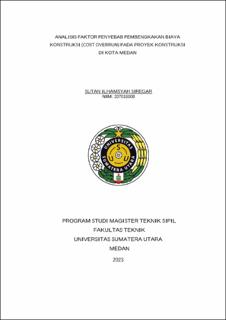| dc.description.abstract | The implementation of construction projects in the Medan City area cannot be
separated from the risk of cost overruns of construction projects, both internal and
external factors, so it is important to carry out an analysis of these factors to
anticipate cost overruns that are detrimental to project implementation. This
research aims to analyze the factors causing cost overruns in construction projects
using the one way ANOVA (analysis of variance) method; to analyze the weight
values of factors that cause and influence construction cost overruns on construction
projects; to analyze the types of construction projects that have a risk of
construction cost overruns based on the size and complexity of the project; and to
analyze the dominant factors that cause and influence construction cost overruns.
This research used quantitative methods, involving 30 respondents using
proportionate stratified random sampling from construction service providers in
Medan City. Data analysis was carried out using SPSS (Statistical Program for
Social Science) version 26, descriptive analysis and one way ANOVA method
analysis, Aiken Rater validity test, and reliability test. The research results showed
that based on the literature review, 33 factors were identified to become 27 factors,
which were grouped into 6 categories. Eleven (11) factors of which are the
dominant factors, namely X6 (work errors (rework), X14 (cost planning errors),
X20 (poor cost control), (Poor team work ability/productivity), X7 (Implementation
time is longer than the planned time (delayed). Based on the respondents'
assessment of the results, 5 of the 6 factors were dominant factors. Factors that
influence the occurrence of cost overruns are based on: XU1 (project size 1)
influencing factors with a project value of ≤2.5m, and In terms of project
complexity, the significance value is 0.353 > 0.05. Thus, H0 is rejected and H1 is
accepted. This means that the causal factor (X) does not have a significant
difference resulting in cost overrun so it can be grouped into dominant or very
influential factors. This research suggests that contractors pay attention to dominant
factors to avoid cost overruns; and further research is needed that focuses on the
magnitude of cost overrun values in construction projects. | en_US |


